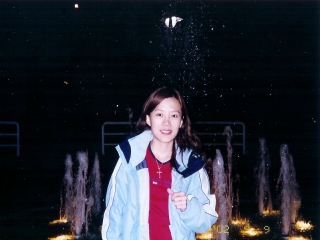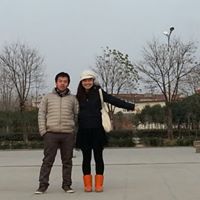Chun Y Yu
age ~55
from Rancho Santa Fe, CA
- Also known as:
-
- Chun Xian Yu
- Chun Chelsea Yu
- Chun Wei Yu
- Chun T Yu
- Chu N Yu
- Chun T Te
- Chun-Wei Yu
- Chun Yui
- Yu Chun-Wei
Chun Yu Phones & Addresses
- Rancho Santa Fe, CA
- 2683 Via De La Valle, Del Mar, CA 92014
- San Diego, CA
- Cupertino, CA
- Sunnyvale, CA
- La Mesa, CA
- San Jose, CA
Isbn (Books And Publications)

Little Green: Growing Up During the Chinese Cultural Revolution
view sourceAuthor
Chun Yu
ISBN #
0689869436
Us Patents
-
System And Method For Clearing Depth And Color Buffers In A Real-Time Graphics Rendering System
view source -
US Patent:6982713, Jan 3, 2006
-
Filed:Jan 13, 2003
-
Appl. No.:10/341842
-
Inventors:Pingping Shao - Sunnyvale CA, US
Jianbo Zhang - Sunnyvale CA, US
Guofang Jiao - Sunnyvale CA, US
Chun Yu - Sunnyvale CA, US
Linglan Zhang - Sunnyvale CA, US
Jinshan Zheng - Shanghai, CN -
Assignee:XGI Technology Inc. - Hsinchu
-
International Classification:G06T 15/40
-
US Classification:345422
-
Abstract:A method and system for clearing depth and color buffers in a real time graphics rendering system. The method and system are able to improve both depth and color buffer clearing. The method and system may utilize a frame flag, a depth clearing module, and a fast color and frame flag clearing module. The system assigns a frame flag to each pixel, which is used to determine whether the current Z value for the pixel is valid. The frame flag may be attached to Z value in the depth buffer. Instead of filling entire depth and color buffers with background values, the system only fills the holes that were not drawn in the previous frame. The fast color and frame flag clearing module traverses a rectangular area, tile by tile, where a tile is a block of pixels, to determine whether each pixel is background by checking the frame flags that are read from the depth buffer. If at least one pixel of a tile is background, the module updates those pixels' color with background color by sending requests to memory interface.
-
Multi-Stage Floating-Point Accumulator
view source -
US Patent:7543013, Jun 2, 2009
-
Filed:Aug 18, 2006
-
Appl. No.:11/506349
-
Inventors:Yun Du - San Diego CA, US
Chun Yu - San Diego CA, US
Guofang Jiao - San Diego CA, US -
Assignee:QUALCOMM Incorporated - San Diego CA
-
International Classification:G06F 7/38
-
US Classification:708501
-
Abstract:A multi-stage floating-point accumulator includes at least two stages and is capable of operating at higher speed. In one design, the floating-point accumulator includes first and second stages. The first stage includes three operand alignment units, two multiplexers, and three latches. The three operand alignment units operate on a current floating-point value, a prior floating-point value, and a prior accumulated value. A first multiplexer provides zero or the prior floating-point value to the second operand alignment unit. A second multiplexer provides zero or the prior accumulated value to the third operand alignment unit. The three latches couple to the three operand alignment units. The second stage includes a 3-operand adder to sum the operands generated by the three operand alignment units, a latch, and a post alignment unit.
-
On-Demand Multi-Thread Multimedia Processor
view source -
US Patent:7685409, Mar 23, 2010
-
Filed:Feb 21, 2007
-
Appl. No.:11/677362
-
Inventors:Yun Du - San Diego CA, US
Guofang Jiao - San Diego CA, US
Chun Yu - San Diego CA, US -
Assignee:QUALCOMM Incorporated - San Diego CA
-
International Classification:G06F 9/00
-
US Classification:712228
-
Abstract:A device includes a multimedia processor that can concurrently support multiple applications for various types of multimedia such as graphics, audio, video, camera, games, etc. The multimedia processor includes configurable storage resources to store instructions, data, and state information for the applications and assignable processing units to perform various types of processing for the applications. The configurable storage resources may include an instruction cache to store instructions for the applications, register banks to store data for the applications, context registers to store state information for threads of the applications, etc. The processing units may include an arithmetic logic unit (ALU) core, an elementary function core, a logic core, a texture sampler, a load control unit, a flow controller, etc. The multimedia processor allocates a configurable portion of the storage resources to each application and dynamically assigns the processing units to the applications as requested by these applications.
-
Pixel Cache For 3D Graphics Circuitry
view source -
US Patent:7737985, Jun 15, 2010
-
Filed:Jan 8, 2007
-
Appl. No.:11/621052
-
Inventors:William Torzewski - San Diego CA, US
Chun Yu - San Diego CA, US
Alexei V. Bourd - San Diego CA, US -
Assignee:QUALCOMM Incorporated - San Diego CA
-
International Classification:G09G 5/36
G06T 15/30
G06T 17/20 -
US Classification:345557, 345423
-
Abstract:Apparatus are provided including device memory, hardware entities, a sub-image cell value cache, and a cache write operator. At least some of the hardware entities perform actions involving access to and use of the device memory. The hardware entities include 3D graphics circuitry to process, for ready display, 3D images from primitive objects. The cache is separate from the device memory, and is provided to hold data, including buffered sub-image cell values. The cache is connected to the 3D graphics circuitry so that pixel processing portions of the 3D graphics circuitry access the buffered sub-image cell values in the cache, in lieu of the pixel processing portions directly accessing the sub-image cell values in the device memory. The write operator writes the buffered sub-image cell values to the device memory under direction of a priority scheme. The priority scheme preserves in the cache border cell values bordering one or more primitive objects.
-
Universal Rasterization Of Graphic Primitives
view source -
US Patent:7791605, Sep 7, 2010
-
Filed:May 1, 2007
-
Appl. No.:11/742753
-
Inventors:Guofang Jiao - San Diego CA, US
William Torzewski - San Diego CA, US
Chun Yu - San Diego CA, US
Brian Ruttenberg - Goleta CA, US -
Assignee:QUALCOMM Incorporated - San Diego CA
-
International Classification:G06T 11/20
G09G 5/00 -
US Classification:345441, 345620
-
Abstract:A technique for universally rasterizing graphic primitives used in computer graphics is described. Configurations of the technique include determining three edges and a bounded region in a retrofitting bounding box. Each primitive has real and intrinsic edges. The process uses no more than three real edges of any one graphic primitive. In the case of a line, a third edge is set coincident with one of its two real edges. The area between the two real edges is enclosed by opposing perimeter edges of the bounding box. In the case of a rectangle, only three real edges are used. The fourth edge corresponds to a bounding edge provided by the retrofitting bounding box. In exemplary applications, the technique may be used in mobile video-enabled devices, such as cellular phones, video game consoles, PDAs, laptop computers, video-enabled MP3 players, and the like.
-
Relative Address Generation
view source -
US Patent:7805589, Sep 28, 2010
-
Filed:Aug 31, 2006
-
Appl. No.:11/469347
-
Inventors:Yun Du - San Diego CA, US
Chun Yu - San Diego CA, US
Guofang Jiao - San Diego CA, US -
Assignee:QUALCOMM Incorporated - San Diego CA
-
International Classification:G06F 12/00
-
US Classification:711220, 711202, 345545
-
Abstract:Techniques to efficiently handle relative addressing are described. In one design, a processor includes an address generator and a storage unit. The address generator receives a relative address comprised of a base address and an offset, obtains a base value for the base address, sums the base value with the offset, and provides an absolute address corresponding to the relative address. The storage unit receives the base address and provides the base value to the address generator. The storage unit also receives the absolute address and provides data at this address. The address generator may derive the absolute address in a first clock cycle of a memory access. The storage unit may provide the data in a second clock cycle of the memory access. The storage unit may have multiple (e. g. , two) read ports to support concurrent address generation and data retrieval.
-
Graphics Processing Unit With Unified Vertex Cache And Shader Register File
view source -
US Patent:7928990, Apr 19, 2011
-
Filed:Sep 27, 2006
-
Appl. No.:11/535809
-
Inventors:Guofang Jiao - San Diego CA, US
Chun Yu - San Diego CA, US
Yun Du - San Diego CA, US -
Assignee:Qualcomm Incorporated - San Diego CA
-
International Classification:G09G 5/36
-
US Classification:345557, 345559, 345606, 345426
-
Abstract:Techniques are described for processing computerized images with a graphics processing unit (GPU) using a unified vertex cache and shader register file. The techniques include creating a shared shader coupled to the GPU pipeline and a unified vertex cache and shader register file coupled to the shared shader to substantially eliminate data movement within the GPU pipeline. The GPU pipeline sends image geometry information based on an image geometry for an image to the shared shader. The shared shader performs vertex shading to generate vertex coordinates and attributes of vertices in the image. The shared shader then stores the vertex attributes in the unified vertex cache and shader register file, and sends only the vertex coordinates of the vertices back to the GPU pipeline. The GPU pipeline processes the image based on the vertex coordinates, and the shared shader processes the image based on the vertex attributes.
-
Graphics System Employing Shape Buffer
view source -
US Patent:7944442, May 17, 2011
-
Filed:Dec 12, 2006
-
Appl. No.:11/609762
-
Inventors:Angus M. Dorbie - San Diego CA, US
Alexei V. Bourd - San Diego CA, US
Chun Yu - San Diego CA, US -
Assignee:Qualcomm Incorporated - San Diego CA
-
International Classification:G06T 15/40
-
US Classification:345421, 345611, 345613, 345614, 345622, 345626
-
Abstract:The system includes a shape buffer manager configured to store coverage data in the shape buffer. The coverage data indicates whether each mask pixel is a covered pixel or an uncovered pixel. A mask pixel is a covered pixel when a shape to be rendered on a screen covers the mask pixel such that one or more coverage criteria is satisfied and is an uncovered pixel when the shape does not cover the mask pixel such that the one or more coverage criteria are satisfied. A bounds primitive rasterizer is configured to rasterize a bounds primitive that bounds the shape. The bounds primitive is rasterized into primitive pixels that each corresponds to one of the mask pixels. A pixel screener is configured to employ the coverage data from the shape buffer to screen the primitive pixels into retained pixels and discarded pixels. The retained pixels each corresponds to a mask pixel that the coverage data indicates is a covered pixel and the discarded pixels each correspond to a mask pixels that the coverage data indicates is an uncovered pixel. The system also includes an attribute generator configured to generate pixel attributes for the retained primitive pixels and also configured not to generate pixel attributes for the discarded primitive pixels.
Resumes

Chun Po Yu
view source
Chun Yu
view source
Chun Nei Yu
view source
Chun Yu
view source
Chun Yu
view sourceLocation:
United States

Chun Yu
view sourceLocation:
United States
Youtube
Flickr
Googleplus

Chun Yu
About:
Hi! Welcome to my blog. Feel free to leave a comment. Add me if you like me. :) Smile always!
Tagline:
Smile is the best medicine! SMILE :)

Chun Yu
Tagline:
Adventurer, blogger, ... definitely not a scientist

Chun Yu

Chun Yu

Chun Yu

Chun Yu

Chun Yu

Chun Yu
Plaxo

Chun Yu Wong
view source
Yu Chun Lin
view sourceAssistant to CEO at KEMFLO

Chun Li Yu
view source
Chun Sing Yu
view source
Chun Chie Yu
view source
Chun Beng Yu
view source
Chun Kwan Yu
view source
Chun Yu
view source
'Maymun Hung Chun Yu
view source
Chester Lee Chun Yu
view sourceClassmates

Chun Yu Tseng, Internatio...
view source
Newcomer High School, San...
view sourceGraduates:
Danny Hin Chun Yu (1998-2000),
Hugo Hernandez (1999-2000),
Karina Zhang (1993-1997),
Jacky Chan (1989-1993),
Chihang Yip (1995-1999),
Ethan Yu (1979-1983)
Hugo Hernandez (1999-2000),
Karina Zhang (1993-1997),
Jacky Chan (1989-1993),
Chihang Yip (1995-1999),
Ethan Yu (1979-1983)

Woodbridge High School, I...
view sourceGraduates:
Margaret Vernillo (1953-1957),
Natalie Grubb (1988-1992),
Paul Barbosa (1997-2001),
Chun Yu (1991-1995),
Kiara Horwitz (2000-2004)
Natalie Grubb (1988-1992),
Paul Barbosa (1997-2001),
Chun Yu (1991-1995),
Kiara Horwitz (2000-2004)

International School, Man...
view sourceGraduates:
Steve Valley (1977-1977),
Brian Williams (1990-1994),
Alan Galpert (1967-1969),
Allan Henderson (1984-1986),
Chun Yu Tseng (1990-1994)
Brian Williams (1990-1994),
Alan Galpert (1967-1969),
Allan Henderson (1984-1986),
Chun Yu Tseng (1990-1994)

Eckstein Middle School, S...
view sourceGraduates:
chun Yu (1981-1983),
Alexis Duran (1997-2000),
Anna Recato (1989-1990),
Geneva James (1995-1999),
Saher Riazuddin (1984-1988),
Daniela Cortes (1995-1999)
Alexis Duran (1997-2000),
Anna Recato (1989-1990),
Geneva James (1995-1999),
Saher Riazuddin (1984-1988),
Daniela Cortes (1995-1999)

Yu Chun Shiue, Boston Art...
view sourceGet Report for Chun Y Yu from Rancho Santa Fe, CA, age ~55













